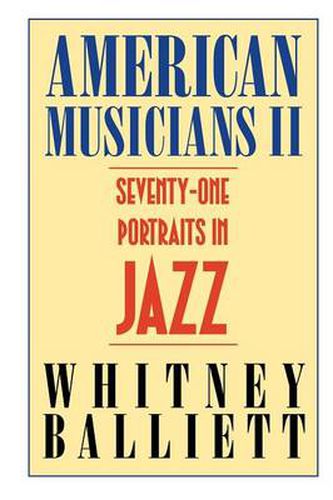Readings Newsletter
Become a Readings Member to make your shopping experience even easier.
Sign in or sign up for free!
You’re not far away from qualifying for FREE standard shipping within Australia
You’ve qualified for FREE standard shipping within Australia
The cart is loading…






This title is printed to order. This book may have been self-published. If so, we cannot guarantee the quality of the content. In the main most books will have gone through the editing process however some may not. We therefore suggest that you be aware of this before ordering this book. If in doubt check either the author or publisher’s details as we are unable to accept any returns unless they are faulty. Please contact us if you have any questions.
This is Whitney Balliett’s long-awaited
big book.
In it are all the jazz profiles he has written for The New Yorker during the past 24 years. These include his famous early portraits of Pee Wee Russell, Red Allen, Earl Hines, and Mary Lou Williams, done when these giants were in full flower; his recent reconstructions of the lives of such legends as Art Tatum, Coleman Hawkins, Jack Teagarden, Zoot Sims, and Dave Tough; His quick but indelible glimpses into the daily (or nocturnal) lives of Duke Ellington and Charles Mingus; and his vivid pictures of such on-the-scene masters as Red Norvo, Ornette Coleman, Buddy Rich, Elvin Jones, Art Farmer, Michael Moore, and Tommy Flanagan. Also included are such lesser known but invaluable players as Art Hodes, Jabbo Smith, Joe Wilder, Warne Marsh, Gene Bertoncini, Joe Bushkin, and Marie Marcus.
All these profiles make the reader feel, as one observer has pointed out, that he is
sitting with Balliett and his subject and listening in.
The book can be taken as a kind of history of jazz, as well as a biographical encylopedia of many of its most important performers. It can also be regarded as a model of American prose. Robert Dawidoff said of Whitney Balliett s most recent book, Jelly Roll, Jabbo and Fats, that
few people write as well about anything as Balliett writes about jazz.
And the late Philip Larkin wrote in 1982 of the
transcendence of Balliett’s prose.
$9.00 standard shipping within Australia
FREE standard shipping within Australia for orders over $100.00
Express & International shipping calculated at checkout
This title is printed to order. This book may have been self-published. If so, we cannot guarantee the quality of the content. In the main most books will have gone through the editing process however some may not. We therefore suggest that you be aware of this before ordering this book. If in doubt check either the author or publisher’s details as we are unable to accept any returns unless they are faulty. Please contact us if you have any questions.
This is Whitney Balliett’s long-awaited
big book.
In it are all the jazz profiles he has written for The New Yorker during the past 24 years. These include his famous early portraits of Pee Wee Russell, Red Allen, Earl Hines, and Mary Lou Williams, done when these giants were in full flower; his recent reconstructions of the lives of such legends as Art Tatum, Coleman Hawkins, Jack Teagarden, Zoot Sims, and Dave Tough; His quick but indelible glimpses into the daily (or nocturnal) lives of Duke Ellington and Charles Mingus; and his vivid pictures of such on-the-scene masters as Red Norvo, Ornette Coleman, Buddy Rich, Elvin Jones, Art Farmer, Michael Moore, and Tommy Flanagan. Also included are such lesser known but invaluable players as Art Hodes, Jabbo Smith, Joe Wilder, Warne Marsh, Gene Bertoncini, Joe Bushkin, and Marie Marcus.
All these profiles make the reader feel, as one observer has pointed out, that he is
sitting with Balliett and his subject and listening in.
The book can be taken as a kind of history of jazz, as well as a biographical encylopedia of many of its most important performers. It can also be regarded as a model of American prose. Robert Dawidoff said of Whitney Balliett s most recent book, Jelly Roll, Jabbo and Fats, that
few people write as well about anything as Balliett writes about jazz.
And the late Philip Larkin wrote in 1982 of the
transcendence of Balliett’s prose.